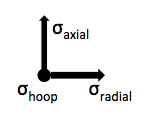Hoop and Axial Stresses in Thick-Walled Pressure Vessels
| Include Page | ||||
|---|---|---|---|---|
|
| Include Page | ||||
|---|---|---|---|---|
|
...
Hoop, Axial and Radial Stresses in Thick-Walled Pressure Vessels
Created using ANYS 14.0
Problem Specification
| Wiki Markup |
|---|
A simply-supported beam of rectangular cross-section is point loaded at some arbitrary point along its length as shown in figure below.
\\
\\ \[\!2dbeam_ps.png\|width=350\!\|^2dbeam_ps.png\]\\
\\
\_P\_ = 10,000 lb, \_L\_ = 100 in, \_a\_ = 75 in, \_b\_ = 3 in, \_h\_ = 8 in
\\
\\
The material is structural steel with Young's modulus \_E_= 2.9e7 psi and Poisson's ratio of 0.3. Using ANSYS Mechanical, find the finite-element solution for non-dimensionalized maximum deflection defined as:
\\ \!2dbeam_eq1.png\!\\
Compare the finite-element solution for plane stress and plane strain to Euler-Bernoulli beam theory. Discuss the comparison between the finite-element and beam theory results. Note that the non-dimensionalized maximum deflection is independent of the Young's modulus. |
Learning Goals
| Wiki Markup |
|---|
The purpose of this tutorial is to showcase how the manner in which assumptions of planar behavior affect the results of analyses in simple beam bending. The plane stress and plane strain assumptions lead to bounds on the actual three-dimensional behavior yet this deceivingly simple analysis to perform is not so readily validated by beginners who are not well-versed in when the planar approximations are reasonable to apply. This analysis culminates in a series of results that can lead a student to "converge" on a substantially incorrect result which is inaccurate by over 100%. The point of this exercise is to have students convince themselves that simplified theories are often bounds and that geometries that do not cleanly and unambiguously lend themselves obviously to either (thin or thick) limit, may still be ones for which one limit is reasonable and applicable. Also, intuitive feel for making and applying these simplifications often eludes beginners. In this way, this tutorial is an exercise in applying caution in interpreting one's results.
\\
Continue to \[Step 1 - Pre-Analysis and Start-Up\|SIMULATION:2D Beam - Pre-Analysis & Start-Up\]
\[Go to all ANSYS Learning Modules\|ANSYS Learning Modules\] |
...
Consider the following pressurized thick-walled hydraulic cylinder. The following figure shows a section through the mid-plane.
Stress directions in cylindrical coordinates:
σhoop is in the circumferential direction (out of the plane here)
a = inner radius = 1.5 in
b = outer radius = 2 in
Assume the cylinders are 18 inches long and the vessel is pressurized to 1000 psi. Here, we will be interested in finding the hoop, axial and radial stresses at the mid-length of the cylinders (@ 9 inches), to neglect the local effects of the end caps.
Compare the finite element results obtained from axisymmetric analysis to those calculated with the theoretical formulae for both thin-wall and thick-wall approximations.
Note: For this problem, the material choice will not affect the stresses; it will only affect the displacements and strains.
...
Planar Approximations for a Two-Dimensional Beam Analysis
Problem Specification
A simply-supported beam of rectangular cross-section is point loaded at some arbitrary point along its length as shown in figure below.
| Wiki Markup |
|---|
\\ \[\!2dbeam_ps.png\|width=350\!\|^2dbeam_ps.png\]\\ |
_P_ = 10,000 lb, _L_ = 100 in, _a_ = 75 in, _b_ = 3 in, _h_ = 8 in
The material is structural steel with Young's modulus _E_= 2.9e7 psi and Poisson's ratio of 0.3. Using ANSYS Mechanical, find the finite-element solution for non-dimensionalized maximum deflection defined as:
!2dbeam_eq1.png!
Compare the finite-element solution for plane stress and plane strain to Euler-Bernoulli beam theory. Discuss the comparison between the finite-element and beam theory results. Note that the non-dimensionalized maximum deflection is independent of the Young's modulus.
Learning Goals
The purpose of this tutorial is to showcase how the manner in which assumptions of planar behavior affect the results of analyses in simple beam bending. The plane stress and plane strain assumptions lead to bounds on the actual three-dimensional behavior yet this deceivingly simple analysis to perform is not so readily validated by beginners who are not well-versed in when the planar approximations are reasonable to apply. This analysis culminates in a series of results that can lead a student to "converge" on a substantially incorrect result which is inaccurate by over 100%. The point of this exercise is to have students convince themselves that simplified theories are often bounds and that geometries that do not cleanly and unambiguously lend themselves obviously to either (thin or thick) limit, may still be ones for which one limit is reasonable and applicable. Also, intuitive feel for making and applying these simplifications often eludes beginners. In this way, this tutorial is an exercise in applying caution in interpreting one's results.
| Wiki Markup |
|---|
Continue to \[Step 1 - Pre-Analysis and Start-Up\|SIMULATION:2D Beam - Pre-Analysis & Start-Up\] |
, in a relatively simple situation, where thin-wall pressure vessel theory is no longer as valid as it is in the limit of large radius-to-thickness ratios. The point is that inadequate theory should not be used for validation purposes in the limit that the physical assumptions on which the theory is based break down. In this problem, this happens gradually as the vessel walls become thicker. This tutorial is meant to highlight where it is relatively straightforward to apply axisymmetric FEA and resolve a solution correctly that disprove analytical treatment with simple formulae derived for thin-walled vessels.
Go to Step 1 - Pre-Analysis & Start-Up
Go to all ANSYS Learning ModulesWiki Markup
 Sign-up for free online course on ANSYS simulations!
Sign-up for free online course on ANSYS simulations!
